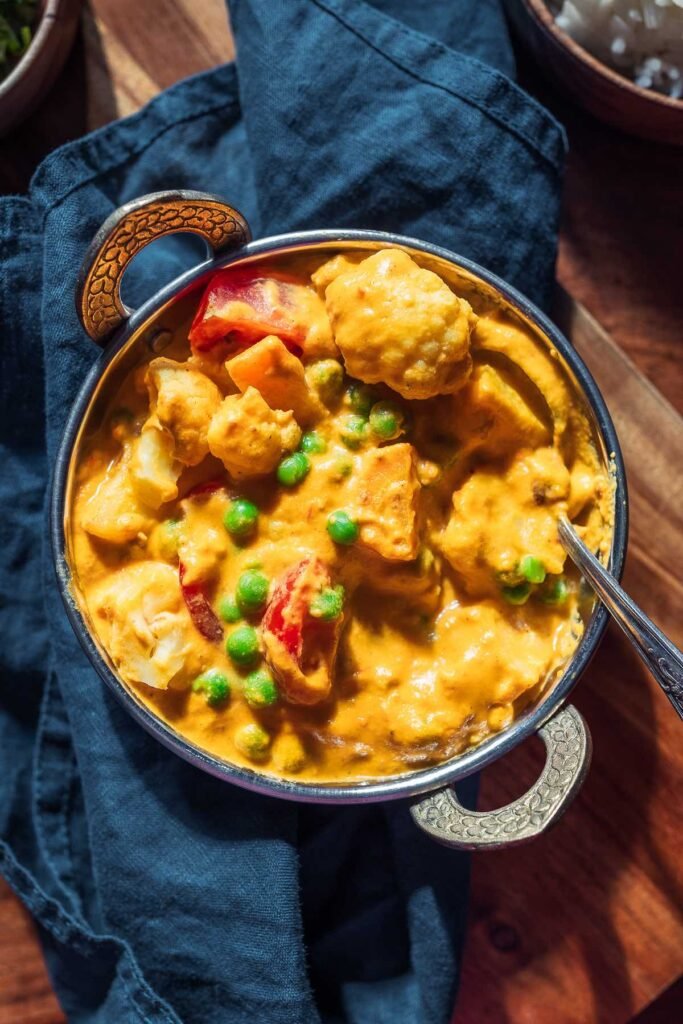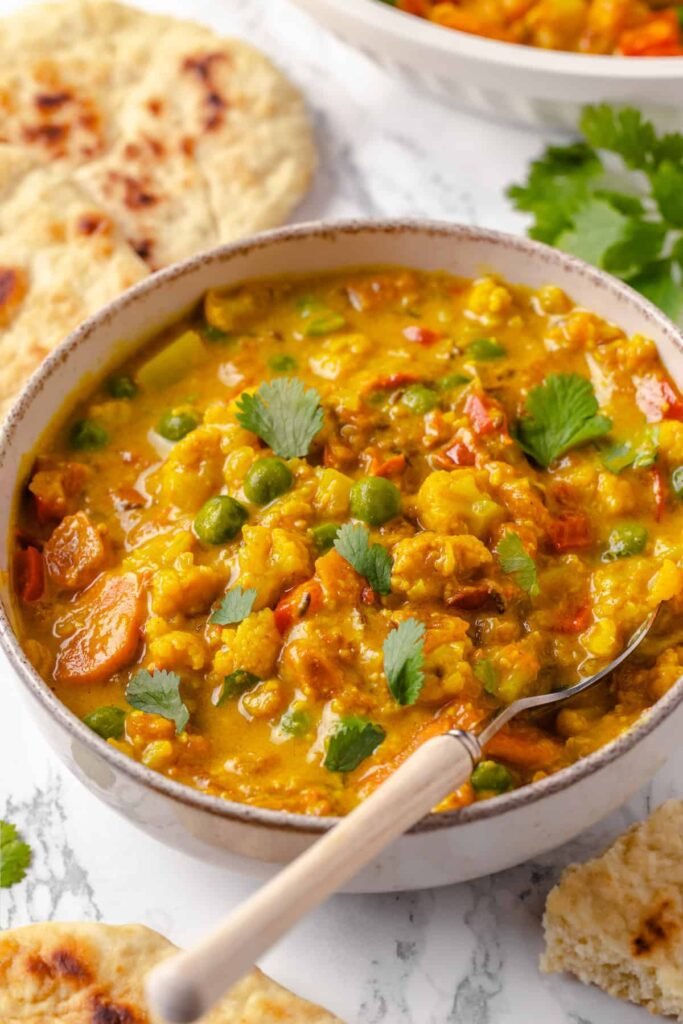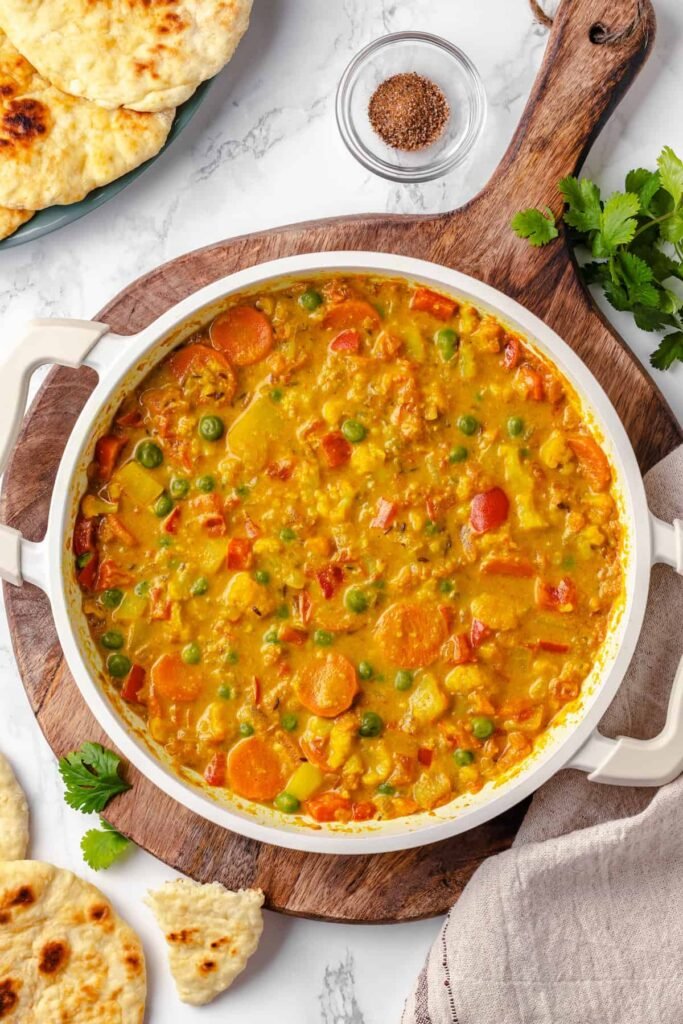Veg Korma is a luxurious, creamy North Indian curry that combines an assortment of vegetables with aromatic spices and a rich, smooth coconut cream base. Known for its mild yet flavorful taste, Veg Korma is perfect for festive occasions, weekend meals, or a hearty dinner. By using coconut cream, this version is lighter than traditional cream-based kormas while still delivering the same indulgent taste.
This guide provides a 6-step process to cook Veg Korma with Coconut Cream, covering ingredient selection, preparation, cooking techniques, and serving tips to make it restaurant-quality at home.
Step 1: Gather Fresh Ingredients

The secret to a perfect Veg Korma lies in using fresh vegetables, aromatic spices, and quality coconut cream.
Ingredients:
Vegetables:
- 1 cup carrots, chopped
- ½ cup beans, chopped
- ½ cup peas
- ½ cup cauliflower florets
- 1 medium potato, cubed
- ½ cup bell pepper (capsicum), diced
For the Korma Gravy:
- Coconut Cream: ¾ cup (or thick coconut milk)
- Onion: 1 medium, finely chopped
- Tomato: 1 medium, pureed
- Ginger-Garlic Paste: 1 tablespoon
- Green Chilies: 1–2, chopped
- Cashews: 10–12, soaked in warm water
- Yogurt (optional for tanginess): 2 tablespoons
- Oil or Ghee: 2 tablespoons
Spices:
- Cumin Seeds – 1 teaspoon
- Turmeric Powder – ½ teaspoon
- Red Chili Powder – ½ teaspoon
- Coriander Powder – 1 teaspoon
- Garam Masala – ½ teaspoon
- Salt – to taste
For Garnish:
- Fresh Coriander Leaves – 2 tablespoons, chopped
- A drizzle of coconut cream (optional)
Tip: Fresh, firm vegetables retain texture and color, making the Korma visually appealing and flavorful.
Step 2: Prepare the Vegetables

Proper preparation ensures even cooking and preserves the natural flavors of the vegetables.
Instructions:
- Wash all vegetables thoroughly.
- Peel carrots, potatoes, and other root vegetables.
- Cut vegetables into uniform bite-sized pieces for even cooking.
- Blanch harder vegetables like carrots, beans, and cauliflower in boiling water for 2–3 minutes to reduce cooking time.
- Keep vegetables in separate bowls for easy addition during cooking.
Tip: Uniform size ensures consistent cooking and texture, which is key to a restaurant-style Veg Korma.
Step 3: Prepare the Korma Base

The Korma base provides creaminess, depth of flavor, and richness.
Instructions:
- Grind soaked cashews into a smooth paste using 2–3 tablespoons of water.
- Heat 2 tablespoons of oil or ghee in a pan over medium heat.
- Add cumin seeds and let them splutter.
- Sauté finely chopped onions until golden brown.
- Add ginger-garlic paste and green chilies, sauté until raw aroma disappears.
- Stir in pureed tomato and cook until the oil separates from the masala.
- Mix in turmeric, red chili powder, and coriander powder.
- Add cashew paste and cook for 2–3 minutes until it blends well with the masala.
Tip: Slow cooking of the masala ensures depth of flavor and prevents raw taste from onions or tomatoes.
Step 4: Cook the Vegetables

Adding vegetables at the right stage ensures they absorb the spices and remain tender.
Instructions:
- Add the blanched or chopped vegetables to the masala.
- Mix gently to coat all vegetables evenly.
- Pour ½–1 cup water to adjust consistency; cover and simmer on low heat for 8–10 minutes until vegetables are tender.
- Stir occasionally to prevent sticking.
Tip: Avoid overcooking vegetables; they should retain slight crunch to maintain texture in the curry.
Step 5: Add Coconut Cream and Final Spices

Coconut cream adds richness without heaviness, giving the Korma a luxurious texture.
Instructions:
- Lower the flame and add ¾ cup coconut cream to the cooked vegetables.
- Stir gently to combine, ensuring the cream doesn’t split.
- Optional: Add 2 tablespoons yogurt for extra tanginess.
- Sprinkle ½ teaspoon garam masala and adjust salt.
- Simmer for 3–4 minutes on low heat, allowing flavors to meld.
Tip: Coconut cream should be added at the end to preserve its smooth, silky texture and mild flavor.
Step 6: Garnish and Serve
Presentation and finishing touches elevate the dish.
Instructions:
- Turn off the heat and garnish with fresh coriander leaves.
- Drizzle a little coconut cream on top for an attractive look.
- Serve hot with:
- Steamed Basmati Rice for a classic pairing
- Naan, Paratha, or Roti for a hearty North Indian meal
- Jeera Rice or Pulao for a festive touch
- Optional: Serve with papad or pickle for additional flavor contrast.
Tip: Veg Korma tastes best fresh while warm, with vegetables maintaining their color and texture.
Extra Tips for Perfect Veg Korma
- Coconut Cream Quality: Use thick, fresh coconut cream for authentic richness.
- Balanced Spices: Mild spices complement the creamy base; adjust chili powder according to taste.
- Vegetable Variety: Use seasonal vegetables like broccoli, zucchini, or bell peppers for variation.
- Cooking Technique: Simmer gently to prevent coconut cream from splitting.
- Cashew Paste: Blending cashews into a smooth paste enhances the creaminess without heavy cream.
Common Mistakes to Avoid
- Overcooking Vegetables: Leads to mushy, colorless curry.
- High Heat with Coconut Cream: Can cause splitting; always add cream on low heat.
- Skipping Cashew Paste: Reduces richness; cashews mimic creaminess naturally.
- Under-seasoning: Proper salt and spices are essential for balanced flavor.
- Ignoring Garnish: Fresh coriander and cream drizzle enhance visual appeal and aroma.
Healthier Variations
- Use light coconut milk instead of cream for a lower-fat version.
- Include more green vegetables for added fiber and vitamins.
- Replace oil/ghee with minimal olive or avocado oil for healthier cooking.
- Pair with brown rice or millet for a complete wholesome meal.
Tip: Even with healthier swaps, careful cooking ensures creamy, flavorful Veg Korma without heaviness.
Serving Suggestions
- Serve as a main dish for festive meals with naan, roti, or paratha.
- Pair with steamed rice or jeera rice for everyday meals.
- Accompany with raita or pickle to balance flavors.
- Garnish with fried onions or roasted cashews for added texture and flavor.
Tip: Veg Korma is versatile and can be included in vegetarian thalis, party spreads, or buffet tables.
Final Thoughts
Making Veg Korma with Coconut Cream at home is simple, flavorful, and allows for customization according to dietary needs. By following these 6 steps—gathering ingredients, preparing vegetables, cooking the korma base, adding vegetables, incorporating coconut cream, and garnishing—you can create a rich, creamy, and aromatic curry that rivals restaurant-style dishes.
This dish combines nutritious vegetables, protein-rich nuts, and creamy coconut, making it a balanced, satisfying, and visually appealing meal. Whether served with rice or Indian breads, Veg Korma is a crowd-pleaser for family meals, festive occasions, or special dinners.
With attention to detail in marination, cooking, and spice balance, you can achieve restaurant-quality Veg Korma at home, delighting family and friends with a wholesome, luxurious meal.





